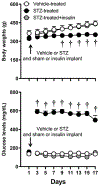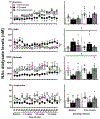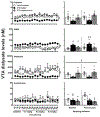Insulin restores the neurochemical effects of nicotine in the mesolimbic pathway of diabetic rats
- PMID: 32562571
- PMCID: PMC7749845
- DOI: 10.1111/jnc.15104
Insulin restores the neurochemical effects of nicotine in the mesolimbic pathway of diabetic rats
Abstract
This study examined whether insulin modulates the neurochemical effects of nicotine in the mesolimbic pathway of diabetic rats. The rats received vehicle or streptozotocin (STZ) to induce hypoinsulinemia. A subset of STZ-treated rats was implanted with insulin pellets that rapidly normalized glucose levels. Two-weeks later, dialysis probes were implanted into the nucleus accumbens (NAc) and ipsilateral ventral tegmental area (VTA). The next day, dialysate samples were collected during baseline and then following systemic administration of nicotine. Samples were also collected following intra-VTA administration of the gamma-aminobutyric acid (GABA)A receptor antagonist, bicuculline. Dopamine, GABA, glutamate, and acetylcholine (ACh) levels were assessed using liquid chromatography/mass spectrometry (LC/MS). The results revealed that vehicle-treated rats displayed a nicotine-induced increase in NAc dopamine levels. In contrast, STZ-treated rats did not display any changes in NAc dopamine following nicotine administration, an effect that was likely related to a concomitant increase in GABA and decrease in glutamate levels in both the NAc and VTA. Intra-VTA administration of bicuculline increased NAc dopamine in vehicle-treated rats, and this effect was absent in STZ-treated rats. Vehicle-treated rats displayed a nicotine-induced increase in ACh levels in the NAc (but not VTA), an effect that was lower in the NAc of STZ-treated rats. Insulin supplementation normalized the neurochemical effects of nicotine in the NAc and VTA of STZ-treated rats, suggesting that insulin modulates the neurochemical effects of nicotine in the mesolimbic pathway of diabetic rats.
Keywords: amino acids; diabetes; dopamine; insulin; micro-dialysis; tobacco use.
© 2020 International Society for Neurochemistry.
Figures







Similar articles
-
Insulin modulates the strong reinforcing effects of nicotine and changes in insulin biomarkers in a rodent model of diabetes.Neuropsychopharmacology. 2019 May;44(6):1141-1151. doi: 10.1038/s41386-018-0306-3. Epub 2019 Jan 7. Neuropsychopharmacology. 2019. PMID: 30647447 Free PMC article.
-
Acute and long-term changes in the mesolimbic dopamine pathway after systemic or local single nicotine injections.Eur J Neurosci. 2002 Jun;15(11):1810-8. doi: 10.1046/j.1460-9568.2001.02009.x. Eur J Neurosci. 2002. PMID: 12081661
-
Nicotine withdrawal produces a decrease in extracellular levels of dopamine in the nucleus accumbens that is lower in adolescent versus adult male rats.Synapse. 2010 Feb;64(2):136-45. doi: 10.1002/syn.20713. Synapse. 2010. PMID: 19771590 Free PMC article.
-
Tribute to: Self-administered nicotine activates the mesolimbic dopamine system through the ventral tegmental area [William Corrigall, Kathleen Coen and Laurel Adamson, Brain Res. 653 (1994) 278-284].Brain Res. 2016 Aug 15;1645:61-4. doi: 10.1016/j.brainres.2015.12.064. Epub 2016 Feb 8. Brain Res. 2016. PMID: 26867702 Review.
-
A psychobiological framework of the substrates that mediate nicotine use during adolescence.Neuropharmacology. 2009;56 Suppl 1(Suppl 1):263-78. doi: 10.1016/j.neuropharm.2008.07.039. Epub 2008 Aug 5. Neuropharmacology. 2009. PMID: 18723034 Free PMC article. Review.
Cited by
-
The emergence of insulin resistance following a chronic high-fat diet regimen coincides with an increase in the reinforcing effects of nicotine in a sex-dependent manner.Neuropharmacology. 2021 Dec 1;200:108787. doi: 10.1016/j.neuropharm.2021.108787. Epub 2021 Sep 24. Neuropharmacology. 2021. PMID: 34571112 Free PMC article.
-
A high-fat diet has sex-specific effects on nicotine vapor self-administration in mice.Drug Alcohol Depend. 2022 Dec 1;241:109694. doi: 10.1016/j.drugalcdep.2022.109694. Epub 2022 Nov 11. Drug Alcohol Depend. 2022. PMID: 36402049 Free PMC article.
-
Compensatory Role of Insulin in the Extinction but Not Reinstatement of Morphine-Induced Conditioned Place Preference in the Streptozotocin-Induced Diabetic Rats.Neurochem Res. 2022 Jun;47(6):1565-1573. doi: 10.1007/s11064-022-03550-y. Epub 2022 Feb 21. Neurochem Res. 2022. PMID: 35188597
-
Insulin effects on core neurotransmitter pathways involved in schizophrenia neurobiology: a meta-analysis of preclinical studies. Implications for the treatment.Mol Psychiatry. 2023 Jul;28(7):2811-2825. doi: 10.1038/s41380-023-02065-4. Epub 2023 Apr 21. Mol Psychiatry. 2023. PMID: 37085712 Free PMC article.
-
Converging vulnerability factors for compulsive food and drug use.Neuropharmacology. 2021 Sep 15;196:108556. doi: 10.1016/j.neuropharm.2021.108556. Epub 2021 Apr 20. Neuropharmacology. 2021. PMID: 33862029 Free PMC article. Review.
References
-
- Arison RN, Ciaccio EI, Glitzer MS, Cassaro JA, and Pruss MP (1967) Light and electron microscopy of lesions in rats rendered diabetic with streptozotocin. Diabetes. 16, 51–56. - PubMed
-
- Bishop FK, Maahs DM, Snell-Bergeon JK, Ogden LG, Kinney GL, and Rewers M (2009) Lifestyle risk factors for atherosclerosis in adults with type 1 diabetes. Diab Vasc Dis Res. 64, 269–275. - PubMed
-
- Bitar M, Koulu M, Rapoport SI and Linnoila M (1986) Diabetes-induced alteration in brain monoamine metabolism in rats. J Pharmacol Exp Ther. 236, 432–437. - PubMed
Publication types
MeSH terms
Substances
Grants and funding
LinkOut - more resources
Full Text Sources
Medical

